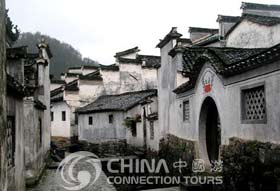
 Probably the most famous of all of China's mountains is the mystical magic Yellow Mountain (Huangshan). Immortalized in ancient and modern Chinese art, this area of hanging mists, sharply rising ledges and gnarled pines is of outstanding beauty, and is considered by most Chinese to be an essential tourist destination. About 450 kilometers southwest of Shanghai, it was formed as a result of the movement of the earth's crust a hundred million years ago.
Probably the most famous of all of China's mountains is the mystical magic Yellow Mountain (Huangshan). Immortalized in ancient and modern Chinese art, this area of hanging mists, sharply rising ledges and gnarled pines is of outstanding beauty, and is considered by most Chinese to be an essential tourist destination. About 450 kilometers southwest of Shanghai, it was formed as a result of the movement of the earth's crust a hundred million years ago.
With a population of 1.4 million, Huangshan City is about 15 times the size of Singapore, and is the largest city in Anhui Province. The Mt. Huangshan range covers an area of 1200 square kilometers (463 square miles). It is the only mountain that is listed in China's top ten scenic spots and designated by the UNESCO World Heritage Committee as a World Cultural and Natural Heritage site. In addition to Mt. Huangshan, Huangshan City offers many other tourist attractions: the well-preserved ancient villages (Xidi and Hongcun villages in Yixian County, the film site of the movie Crouching Tiger, Hidden Dragon), archways (in Shexian County), Taiping Lake (in Huangshan District) and Qiyun Taoist Mountain (in Xiuning County). Old houses, clan temples, ancient bridges and pagodas are abundant.
Huangshan Mountain was known as Yishan in the ancient times. In 747, Emperor Li Longji of the Tang Dynasty believed that the Yellow Emperor Xuanyuan became an immortal here so he changed the name of the mountain to Huangshan (Yellow Mountain).
Huangshan Mountain is a marvel. Within an area of 154 square kilometers, there are 72 peaks, which have names indicating the shapes they resemble. Lotus, Brightness Apex and Celestial Capital are the three major ones, all rising above 1,800 meters. Huangshan Mountain changes color and appearance with the seasons. In spring, blooming flowers decorate the slopes in a riot of color and fill the valleys with fragrance; in summer, you see foliage clad peaks rising one upon another and hear springs gurgling merrily. Autumn dresses the peaks in red and purple; winter turns the mountain into an enchanted world of frost and ice. The fantastic pines, grotesque rocks, sea of clouds and the hot springs are the four major attractions of Huangshan Mountain.
Huangshan is a large botanical garden with over 1,500 species of plants and trees. More than 300 kinds of medicinal herbs are found here. Maofeng Tea of Huangshan Mountain is well known. The mountain provides a natural habitat for a wide variety of animals. Among them are monkeys, goats and deer. There are rare birds such as the silver pheasant, octave-tone bird and the oriole. Huangshan has been immortalized in poetry and art. Many master poets and painters have come to Huangshan to write and paint, inspired by the beautiful scenery.
 The temperature changes vertically on Mt. Huangshan, and the climate of the mountain varies by elevation. It generally has 3 climate types from the base to top: subtropical mountain base, temperate mountainside and frigid mountaintop. The sun shines an average of 151 days a year. On the mountain top humidity averages about 90% in July and August, and around 60% in December and January. The heaviest rainfall area in Anhui province is on Mt. Huangshan, where rain falls on an average of 183 days a year, most of it coming in the months of May, June, July, August and September. Mt. Huangshan has little rain and more sunshine in winter and the average annual snow lasts 49 days.
The temperature changes vertically on Mt. Huangshan, and the climate of the mountain varies by elevation. It generally has 3 climate types from the base to top: subtropical mountain base, temperate mountainside and frigid mountaintop. The sun shines an average of 151 days a year. On the mountain top humidity averages about 90% in July and August, and around 60% in December and January. The heaviest rainfall area in Anhui province is on Mt. Huangshan, where rain falls on an average of 183 days a year, most of it coming in the months of May, June, July, August and September. Mt. Huangshan has little rain and more sunshine in winter and the average annual snow lasts 49 days.

